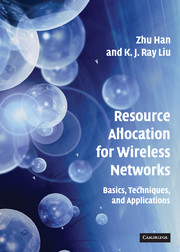2 - Wireless Networks: An Introduction
from Part I - Basics Principles
Published online by Cambridge University Press: 05 August 2012
Summary
Introduction
“Wireless network” refers to a telecommunications network whose interconnections between nodes is implemented without the use of wires. Wireless networks have seen unprecedent growth during the past few decades and will continuously evolve in the future. Seamless mobility and coverage ensure that various types of wireless connections can be made anytime, anywhere. In this chapter, we introduce some basic types of wireless networks and give the readers some preliminary backgrounds for the current state-of-the-art development.
Wireless networks use electromagnetic waves, such as radio waves, for carrying information. Therefore the performance is greatly influenced by randomly fluctuating wireless channels. To understand the channels, in Section 2.2, we will study the existing wireless channel models used for different network scenarios.
There are many existing wireless standards. We consider them according to the order of coverage area, and start with cellular wireless networks. The third-generation (3G) wireless cellular network standards have been enhanced to offer significantly increased performance for data and broadcast services through the introduction of high-speed downlink packet access, enhanced uplink, and multimedia broadcast multicast services. In Section 2.3, we provide an overviewof the key elements and technologies. Specifically, we discuss WCDMA, CDMA2000, TD/S CDMA, and 4G and beyond.
WiMax, based on the IEEE 802.16 standard for a wireless metropolitan-area network (WMAN), is expected to enable true broadband speeds over wireless networks at a cost that enables mass-market adoption. WiMAX has the ability to deliver true broadband speeds and help make the vision of pervasive connectivity a reality. We discuss some techniques and the standard in Section 2.4.
- Type
- Chapter
- Information
- Resource Allocation for Wireless NetworksBasics, Techniques, and Applications, pp. 9 - 54Publisher: Cambridge University PressPrint publication year: 2008

